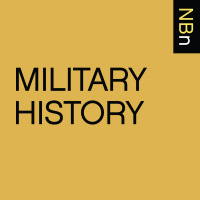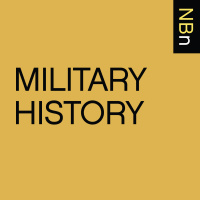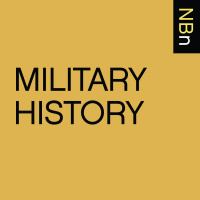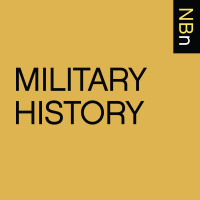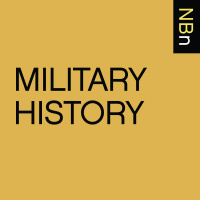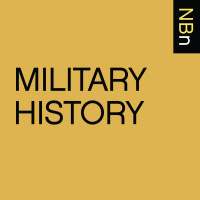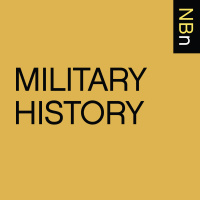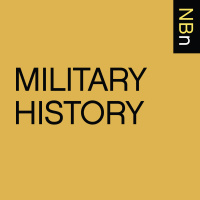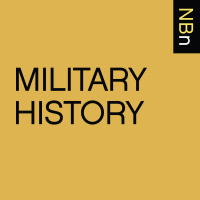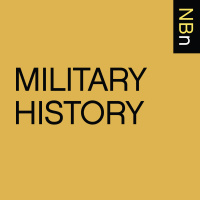Sinopsis
Interviews with Scholars of Military History about their New Books
Episodios
-
Steven H. Jaffe, “New York at War: Four Centuries of Combat, Fear, and Intrigue in Gotham” (Basic Books, 2012)
11/08/2012 Duración: 01h28minMany people – including myself – are no doubt surprised to learn about New York City’s rich four hundred year military history. I teach in Flushing, New York, deep in the heart of Queens, at one of the country’s largest public universities. And in my American History survey classes, I strive to bring as much of the city’s history to bear as possible. Now after reading Steven Jaffe‘s book, New York at War: Four Centuries of Combat, Fear, and Intrigue in Gotham (Basic Books, 2012), I realize that I could do a lot more covering New York’s military history. Jaffe escorts his reader on a dramatic tour of New York at war, from the settlement of New Amsterdam by the Dutch in 1624, to the city’s response to the September 11, 2001 attack on the World Trade Center. It is an entertaining and informative tour, and one which I can attest will certainly affect my own treatment of the city’s history in my classes. Overall New York at War is a pleasure for all readers, bu
-
Richard Bessel, “Germany 1945: From War to Peace” (Harper, 2009)
02/07/2012 Duración: 55minOne chilling statistic relating to 1945 is that more German soldiers died in that January than in any other month of the war: 450,000. It was not just the military that suffered: refugees poured west to escape the brutality of the Red Army’s advance through the historic German lands of East Prussia, Pomerania and Silesia; and civilians in the cities bore the brunt of the Luftwaffe’s failure to stem the allied bombing campaign of the RAF at night time and the USAAF during the day. The staggering scale of losses during those last months of war also hints at why 1945 is such a grimly fascinating one from a historical perspective: Nazi Germany faced an inevitable end, yet continued to fight grimly until the bitter end, achieving a total defeat that was unprecedented in modern history. In doing so it created a ‘zero hour’ for the German people, who then set about rebuilding their lives, economic activity and ultimately Germany itself, with the Nazi era firmly in the past. The legacy of the
-
Gregory A. Daddis, “No Sure Victory: Measuring U.S. Army Effectiveness and Progress in the Vietnam War” (Oxford UP, 2011)
17/06/2012 Duración: 54minAsk any student or aficionado of the Vietnam War (1965-1972) for a top ten list of artifacts “unique” to the war, and chances are the phenomenon of “body counts” as a tool for measuring success in the field will come up. Indeed, the use of casualty metrics, while not the sole means of calculating progress in this unconventional war, was one of the Army’s most heralded – and subsequently, most criticized – assessment tools. Taking its place alongside more esoteric metrics, such as gauging security on the basis of population resettlement, calculating the denial of strategic space by measuring raw acreage of defoliated land, and estimating anticipated casualties on the basis of ordnance tonnage expended on a defined area, body counts became the most visibly broken method employed by the Pentagon during the war. Even now, nearly fifty years after the war began, historians continue to debate the effectiveness of such metrics, and how they did or did not accurately portray
-
Raymond Jonas, “The Battle of Adwa: African Victory in the Age of Empire” (Harvard UP, 2011)
01/05/2012 Duración: 36minRaymond Jonas‘ The Battle of Adwa: African Victory in the Age of Empire (Harvard UP, 2011) places Menelik alongside Napoleon and other greatest strategists. The Ethiopian emperor carried out a brilliant maneuver across hundreds of miles, essentially defeating his Italian adversaries without battle. That battle came was the colossal blunder of the Italians and one that cost thousands of Italian and Askari soldiers their lives. More than just the history of the campaign, The Battle of Adwa provides keen insights into Menelik’s court and elucidates Italian imperial ambitions.Learn more about your ad choices. Visit megaphone.fm/adchoices
-
Anna Krylova, “Soviet Women in Combat: A History of Violence on the Eastern Front” (Cambridge UP, 2010)
27/04/2012 Duración: 01h24minWe’re all familiar with the film cliche of the little band of soldiers who in ordinary life never would have had met, but who learn to appreciate each other in the battles of World War II. All white, of course: African Americans would have to wait till the integration of the armed forces. But still, there’s a kind of earnest 1940s diversity in those movies: maybe a wide-eyed kid from the farm, a privileged college boy, and a Jewish guy from Brooklyn. With some subplot about a faithful girlfriend, or maybe an unfaithful one, back home. In the Red Army, the situation was a little different. There, the women were snipers, tank drivers, combat pilots, machine gunners, and the like: skilled purveyors of lethal violence, serving side by side with men (and sometimes above them, as their commanding officers). This was the first Soviet generation, educated in co-educational schools where everyone participated in paramilitary exercises and no one took home economics. When the long-awaited war with Germany
-
Karen Petrone, “The Great War in Russian Memory” (Indiana UP, 2012)
20/04/2012 Duración: 55minHistorical studies on the European memory of World War I are, to put it mildly, voluminous. There are too many monographs to count on a myriad of subjects addressing the acts of remembrance and commemoration of the so-called war to end all wars. But when it comes to Russia, from which 15 million men fought, 2 million died, 5 million were captured and an estimated 1.5 million civilians perished, there is a strange historiographical silence. In fact historians of Russia speak more often of an absence of memory because the Bolshevik revolution labeled WWI as an “imperialist war,” and thus rendering its remembrance illegitimate. It is because of this silence that Karen Petrone‘s The Great War in Russian Memory (Indiana University Press, 2012) is such an illuminating and refreshing book. Petrone shows that much like their European counterparts Russians produced a rich memory of the war, even within the strictures of the Soviet system. And the issues that memory addressed were many we assume were
-
David Edgerton, “Britain’s War Machine: Weapons, Resources and Experts in the Second World War” (Oxford UP, 2011)
22/03/2012 Duración: 43minMy grandfather joined up when the Second World War broke out, but he was soon returned to civvy street as he was much more valuable employing his mechanic’s skills to fight the Nazis from a factory in Newcastle. He ended up making the parts of the spot lights that were used to guide anti-aircraft batteries (and my grandmother made parachutes, just over the River Tyne in Gateshead). Although this was not half as exciting to find out about as a young boy as discovering that he was in fact a Commando or part of the Long Range Desert Group, what my grandfather was part of was vital to the defeat of Nazism. In his excellent book, Britain’s War Machine: Weapons, Resources and Experts in the Second World War (Oxford University Press, 2011), David Edgerton is all about this crucial non-military part of Britain’s war with Germany, and it sets about challenges perceptions almost from the front page. His argument is that Britain was actually far more able and well resourced than commonly thought. It en
-
Jorg Muth, “Command Culture: Officer Education in the U.S. Army and the German Armed Forces, 1901-1940” (UNT Press, 2011)
12/03/2012 Duración: 01h18minThis week we’re continuing our focus on the Second World War, as our guest author, Jorg Muth, chats about his recent book Command Culture: Officer Education in the U.S. Army and the German Armed Forces, 1901-1940, and the Consequences for World War II (University of North Texas Press, 2011). Muth’s book, which has recently been selected for the U.S. Army Chief of Staff’s Professional Reading List, is a provocative analytical comparison of the respective cultures of officership in the US Army and the German armed forces in the first half of the twentieth century. In setting up his comparison, Muth pulls few punches in his critique of the flaws resident in both institutions. Yet while the American army managed to overcome these flaws, Muth notes that the Wehrmacht ultimately fell victim to its own hubris and ossified culture inherent in its origins. He continues to offer valuable insights as to how these institutional problems and successes continue to shape the culture of officership in the U
-
Marcus Franke, “War and Nationalism in South Asia: The Indian State and the Nagas” (Routledge, 2011)
21/02/2012 Duración: 01h08minNorth East India is, as Marcus Franke’s War and Nationalism in South Asia: The Indian State and the Nagas (Routledge, 2011) all too convincingly demonstrates, often considered peripheral to ‘India (or even South Asia) proper.’ A densely wooded, sparsely populated tract of hills (in fact the Eastern Himalayas), the moniker refers to the Indian states of Assam, Arunachal Pradesh, Nagaland, Mizoram, Meghalaya and Tripura, with the former kingdom of Sikkim often included. This beautifully diverse, hard to reach region is today home to dozens of separatist movements, fighting against what is often referred to as the Government of India’s indifference, perhaps hostility, to the cultures and lifestyles of the region- customs and rituals which vary sharply from those of the plains of India. Border disputes with China and Bangladesh, and amongst the states, add to regional instability and have resulted in heavy militarization- Marcus’ book talks about the engagement between the Indian gov
-
David Stahel, “Operation Barbarossa and Germany’s Defeat in the East” (Cambridge UP, 2009)
13/02/2012 Duración: 01h03minThis week’s podcast is an interview with David Stahel. I will be talking to him about his 2009 work, Operation Barbarossa and Germany’s Defeat in the East (Cambridge University Press, 2009). One of our previous guests, Matthias Strohn, recommended the book, and I am glad he did. Stahel’s book is an important contribution to our understanding of German planning for and execution of Operation Barbarossa. Stahel highlights the many flaws and paradoxes intrinsic to German thinking about war in the East, not least of which was the deception perpetrated by Halder, who masked the centrality of the drive on Moscow to his own plans in order to avoid confrontation with Hitler. By late August 1941, Stahel argues, the German failure decisively to defeat the Soviet regime (even while winning significant victories at places like Minsk and Smolensk) spelled doom for the Wehrmacht. Nor is Stahel resting on his laurels. By the time I conducted the interview, his second work had just hit the shelves. In Kiev
-
Cynthia Wachtell, “War No More: The Antiwar Impulse in American Literature, 1861-1914” (LSU Press, 2010)
03/02/2012 Duración: 01h07minMy favorite book as a teenager (and in fact the only book I ever read as a teenager) was All Quiet on the Western Front. I liked it mostly for the vivid scenes of trench warfare. Teenage boys love that stuff (or at least I did). But even then I recognized that it was essentially an anti-war book. It was hard to miss: the protagonist, Paul, has a pretty nasty time of it in the trenches, and he gets killed at the end. In the years that followed I somehow got the impression that All Quiet was essentially the first real anti-war book. Before WWI, I thought, everyone who wrote about war glorified it. As Cynthia Wachtell shows in War No More: The Antiwar Impulse in American Literature, 1861-1914 (Louisiana State University Press, 2010), I was just dead wrong about this. In American letters anti-war sentiment abounded. Many of the leading lights of American lit wrote anti-war tracts, and some of them were remarkably “modern” (those by Ambrose Bierce are particularly astonishing, and I highly recommend
-
Artemy Kalinovsky, “A Long Goodbye: The Soviet Withdrawal from Afghanistan” (Harvard UP, 2011)
16/01/2012 Duración: 01h05minIt’s been twenty years since the Soviet Union collapsed, and scholars still joust over its long- and short-term causes. Amid the myriad factors–stagnating economy, reform spun out of control, globalization, nationalism–the Soviet war in Afghanistan figures in many narratives. Indeed, the ten-year intervention was the one of hottest and bloodiest conflicts in the Cold War, and its traumatic legacies among a generation of Russian citizens continue to resonate. Interestingly, Artemy Kalinovsky emphasizes in A Long Goodbye: The Soviet Withdrawal from Afghanistan (Harvard University Press, 2011) that the intervention was a “reluctant one,” which the Soviet leadership quickly recognized as a quagmire. Yet the Soviets postponed the inevitable out of a belief that they could stabilize country, help build an Afghan army, and create legitimacy for the government in Kabul. In the end it took Mikhail Gorbachev and his foreign policy of New Political Thinking to extricate a beleaguered Red A
-
Michael Matheny, “Carrying the War to the Enemy: American Operational Art to 1945” (University of Oklahoma Press, 2011)
16/12/2011 Duración: 55minAsk many military historians about the origins of American operational art and many will place it sometime after the Second World War. Conventional wisdom has long held that the American military only developed a rough understanding of operations – the planning and conduct of large-scale (Corps-size or greater) coordinated offensive and defensive actions – in the twin crucibles of the European Theater of Operations and in the US Navy’s drive across the Central Pacific. These traditionalist accounts have generally put the United States Army in the role of either being reluctant students, schooled in the nuances of modern warfare by the masters of the art, the German Wehrmacht, or as being pulled along unwillingly by the more sophisticated Navy and Marine Corps. If that is what passes for conventional wisdom, then Michael Matheny is having none of it. A senior instructor at the United States Army War College and a retired Army officer, Matheny is the author of Carrying the War to the Enemy: Am
-
Timothy Nunan, “Carl Schmitt, ‘Writings on War'” (Polity Press, 2011)
25/10/2011 Duración: 01h07minCarl Schmitt (1888-1985) was the author of numerous influential books and essays on political theory, law, and other subjects. In Carl Schmitt: Writings on War (Polity Press, 2011), Rhodes Scholar Timothy Nunan has provided us with an excellent translation of three of Schmitt’s essay on military affairs. These essays are relevant from a variety of perspectives. They reflect interwar debates about international law, neutrality, and the League of Nations and so are of interest to historians of the period. Schmitt was also a fervent supporter of Hitler and the Nazi party and so it may be surprising that his influence (note his longevity) may in some ways be increasing. His ideas about what constitutes an empire, his thoughts on “just war,” and on war crimes demand our attention despite our revulsion at his political views. For making more of Schmitt’s work accessible to an English-speaking audience, Nunan is to be thanked.Learn more about your ad choices. Visit megaphone.fm/adchoices
-
Peter Mauch, “Sailor Diplomat: Nomura Kichisaburo and the Japanese-American War” (Harvard University Asia Center, 2011)
17/10/2011 Duración: 01h02minPeter Mauch‘s Sailor Diplomat: Nomura Kichisaburo and the Japanese-American War (Harvard University Asia Center, 2011) is an exhaustively researched and very rich biographical account of the man who was Japan’s ambassador to the US in the years leading up to the Pearl Harbor attack. Mauch traces the geopolitical developments of Japanese/US relations from 1877-1951, a crucial period that embraces two World Wars and many fascinating transformations in modern transnational history. The book relates this story through the life of Nomura, naval officer turned ambassador, allowing readers a rare glimpse into the processes and negotiations through which this sailor-diplomat wrestled with conflicting senses of duty, commitment, and reason. A boon not only for scholars of Japan, the book is also a fascinating model of the historian’s craft in its use of biography to simultaneously offer a macro-history of modern global politics, and a micro-history of a vibrant and critical mind reasoning in the cour
-
David J. Ulbrich, “Preparing for Victory: Thomas Holcomb and the Making of the Modern Marine Corps, 1936-1943” (Naval Institute Press, 2011).
05/10/2011 Duración: 01h11minThe story of the United States Marine Corps in the Pacific Theatre in the Second World War is no doubt quite familiar to our listeners. Less well known, however, is the story of how the Marine Corps readied itself for the challenges of amphibious warfare during the interwar period. No less obscure is the record of the Corps’ first commandant, Thomas Holcomb. Generally overshadowed by the combat narrative of the Marines’ first year in the South Pacific and the subsequent tenure of his successor, Alexander Vandegrift, Holcomb has long been skipped over by scholars and students. Historian David Ulbrich remedies this oversight in his Preparing for Victory: Thomas Holcomb and the Making of the Modern Marine Corps, 1936-1943 (Naval Institute Press, 2011). This well-received book presents its subject as a model of the Progressive Era officer who shepherded the American military into the modern era. Despite his mild demeanor, Holcomb – a combat veteran of the First World War and an experienced R
-
John Grenier, “The Far Reaches of Empire: War in Nova Scotia, 1710-1760” (University of Oklahoma Press, 2008)
23/09/2011 Duración: 46minFor many readers, colonial history begins and ends with the original 13 American colonies. This perception overlooks the other British colonies throughout the New World, each of which created their own unique challenges for their imperial master. Historian John Grenier considers one of these “other” colonies in his book The Far Reaches of Empire: War in Nova Scotia, 1710-1760 (University of Oklahoma Press, 2008). Part of the Campaigns and Commanders series from the University of Oklahoma Press, Grenier’s book builds upon the framework he constructed in an earlier work, The First Way of War: American War Making on the Frontier, 1607-1814 (Cambridge University Press, 2005). There he introduced the idea that a uniquely American way of war evolved in response to the clash of cultures taking place in the New World, drawing equally from the realities and perceptions of war with the Native Americans and the petit guerre -“little war” or irregular war – of the European continent. I
-
Charles Townshend, “Desert Hell: The British Invasion of Mesopotamia” (Harvard University Press, 2011)
31/08/2011 Duración: 01h05minAn earlier author described the British invasion of Mesopotamia in 1914 as “The Neglected War.” It no longer deserves that title thanks to the brilliant treatment of the subject by Professor Charles Townshend (University of Keele). His Desert Hell: The British Invasion of Mesopotamia (Harvard University Press, 2011) describes in impressive detail both the political background and the military operations that made modern-day Iraq quite literally hell for the British soldiers engaged there from 1914 to 1918. A parsimonious British administration waged the campaign, seen at the time quite understandably as something of a peripheral concern, on a shoestring, and the absence of the most basic materials, especially shipping and medical supplies, was paid for by the largely Indian soldiery in blood. Using sources ranging from the highest level strategic plans and parliamentary inquiries, to the quasi-anthropological studies of Gertrude Bell and T.E. Lawrence, to the memoirs and letters of the common sold
-
Rodric Braithwaite, “Afgantsy: The Russians in Afghanistan, 1979-89” (Oxford UP, 2011)
26/08/2011 Duración: 01h06minI was still in high school the year the Soviet Union invaded Afghanistan, 1979. I remember reading about it in Time magazine and watching President Carter denounce it on TV. The Soviets, everyone said, were bent on ruling the world. Detente had been a ploy to lull us to sleep. In Afghanistan, the Communists had renewed their campaign. We had to do something. So we didn’t go to “their” Olympics. Oddly, that brave gesture failed to bring them around to our way of thinking. There are two really wonderful things about Sir Rodric Braithwaite‘s new book Afgantsy: The Russians in Afghanistan, 1979-89 (Oxford UP, 2011). First, Sir Rodric shows in excruciating detail just how wrong we got it. The tiny cabal of Soviet leaders who sent the Red Army into Afghanistan weren’t imperialists pursuing some grand strategy to conquer the globe. They were scared, sometimes confused old men in a situation that was made impossible by conflicting, contradictory aims. They wanted to protect the USSR̵
-
Michael Neiberg, “Dance of the Furies: Europe and the Outbreak of World War I” (Harvard University Press, 2011)
04/08/2011 Duración: 49minAs we close in on the centennial of the First World War, no doubt there will be a flood of new interpretations and “hidden histories” of the conflict. Many books will certainly promise much, but in the end deliver little. Fortunately this is not the case with Michael Neiberg‘s latest book Dance of the Furies: Europe and the Outbreak of World War I (Harvard University Press, 2011). In this important new view of the opening months of the war, Neiberg offers a fresh look at the July Crisis, how it was perceived across Europe, and the first two months of the war. Rather than focusing on the same old voices of the European literati and political elites, Neiberg shows us how the average person considered the march to war. In the process he reveals a number of startling insights that challenge the war’s standard historical orthodoxy, revealing that many of our assumptions about the collective and individual responses to the July Crisis are based on misperception and poor assumptions. Rather


